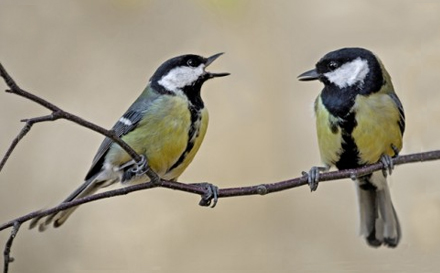Shy male tits stick together, take more risks

Shy birds stick together and gain courage through numbers, whereas bold birds go it alone according to new research.
Within species of birds, such as the British great tit (Parus major), there is a variety of personalities and scientists have been studying how the range of traits persists through generations and structures societies.
“There has been a lot of work describing the range of individual personalities in the great tit,” says Lucy Aplin, a PhD student with the Cockburn Lab at the ANU Research School of Biology and the University of Oxford.
“Now we are linking it to the social networks and social organisation of the species, which hasn’t been done before.”
Aplin was part of an international research team that rated great tits on a personality axis ranging from shy to bold. The team tracked how they interacted with other birds to determine how their personality influenced social behaviour.
Bold birds went for quantity over quality in their relationships, having weaker associations with more birds and foraging with several different groups.
“Measuring the social networks we could see that bolder birds tended to hop between foraging flocks and have short term foraging associations, while shy birds tended to maintain a foraging association over a long time.”
This difference in behaviors is likely to be due to the differing responses to risk – shy birds tend to engage in low risk/low reward behavior, whereas their bolder counterparts engage in high risk/high reward behavior.
“Shy birds are following a social strategy where they maintain a few strong and stable social associations to minimise risk.”
“Hopping between many flocks increases risk for bolder birds, but might maximize rewards through improving their social position and giving them better access to information, such as the location of food.”
The research team found that birds of a feather do indeed flock together, finding shy males most often associated with similar personalities.
“We think shy male birds might group together to avoid the more aggressive bold birds,” says Aplin, who went on to explain that females associate freely with all personalities.
“Grouping together might allow shy birds to engage in risk-taking behaviour that would otherwise be avoided.”
“Understanding how personality is related to social network structure in turn helps us to understand how personality and sociality evolved. We are exploring how a range of alternative social strategies could coexist in the one population,” concludes Aplin.
This research was published in Ecology Letters.
Related links
- Aplin LM, Farine DR, Morand-Ferron J, Cole EF, Cockburn A, & Sheldon BC. Individual personalities predict social behaviour in wild networks of great tits (Parus major). Ecology Letters.
- Original article: Shy male tits stick together, take more risk, ANU Media article
- Shy male birds keep closer 'friends' BBC Nature
 Personality in great tits, BBC YouTube Video
Personality in great tits, BBC YouTube Video- Birds of a feather really DO flock together: Study finds they seek out mates with similar personalities, Daily mail (Mail online: Science & Tech)
